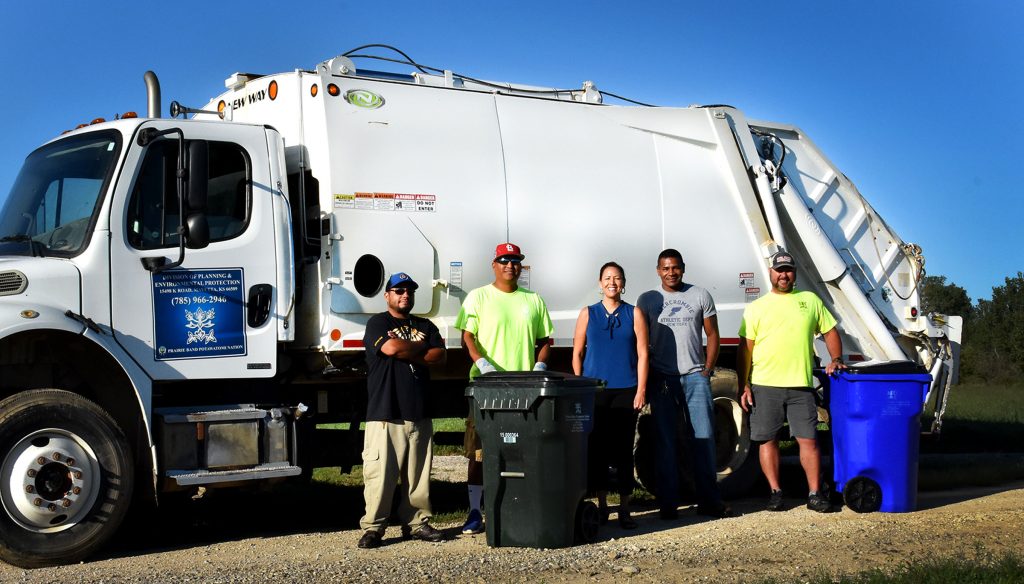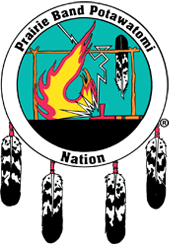
Prairie Band Potawatomi Nation Planning and Environmental Protection staff have evolved the Nation’s solid waste management program into one of the most advanced tribal programs in the United States. From left: Recycling Assistant Albert Torrez, Environmental Specialist Kyle Miller, Environmental Manager Virginia LeClere, Waste Water Coordinator Marcus Oliveira and Waste Disposal Drive Chris Sims. (Verna Potts & Billie Toledo not pictured).
8.28.19
By: Michelle Simon
The PBPN Planning and Environmental Protection department is the protector of the Nation’s land, water, natural resources, and public health.
The stewardship of the Nation’s natural resources is the domain of the Planning and Environmental Protection department. Environmental Manager and PBPN tribal member, Virginia “Osh” LeClere and her staff of eight have streamlined their work into three broad divisions: waste and wastewater management, environmental protection, and land use planning. Within each division are several programs, each with their own planning and management documents. Following is a prime example of how their processes tie together to create impactful change in the community, along with an overview of the department.
The on-going story of the Nation’s solid waste management practices perfectly highlight the intersection of how planning impacts the environment, with the Prairie Band Potawatomi Nation now having one of the most advanced tribal solid waste programs in the country.
In the early 2000’s, the Nation utilized eight public dumpsters on the common land. These dumpsites, intended for use by community tribal members, were being used by anyone and everyone to dump anything and everything, with 100% of the cost being paid by the Nation. The conditions at the sites became atrocious, with garbage spilling out from the dumpsters and sometimes hazardous chemical waste being left in the open. PEP staff spent a large amount of time cleaning the sites regularly. It was time for a change.
In 2008, the PEP department began the planning process to change this situation, and over the course of a few years, they transitioned from anything-goes open dumpsites to individual responsibility with curbside waste disposal and recycling services in 2012. The success of this service, now in its 7th year, was heavily dependent on the support of past and present Tribal Councils, education outreach to community members by PEP staff and the pride within the Prairie Band Potawatomi community to keep the environment clean. The PEP department made sure customers and Nation employees had the information they needed to be successful at managing their waste and learning what and how to recycle.
The solid waste management plan is not static. It is reviewed on a 5-year term and consistently tweaked. An integral component of the plan includes waste stream analysis. PEP staff reviews the percentage of customers’ waste to see what is being thrown away versus being recycled. They use the analysis to design an efficient waste reduction strategy for the community. In the last analysis, they recognized a significant amount of food waste in the trash. This spurred the development of the food waste compost program. PEP now collects food waste from the casino for composting and educates the community about composting. A recent education/outreach activity included the distribution of compost containers.
The PEP department has found that implementing a philosophy of encouraging individual responsibility has led to greater outcomes in people practicing better waste habits, which essentially results in less waste and less cost to the consumer in the long run. In the near future, the department would like to depart from a blanket cost per container and advance the program, so customers pay for what they are actually disposing of.
The positive changes made in the Nation’s approach to solid waste management highlight how essential partnerships are to the department.
“We are really reliant on the support we receive, not only from federal and granting agencies, but from the resources within the tribe, the Tribal Council and the Lands, Construction and Building Maintenance, Road & Bridge, and Finance departments, along with other tribes we work with and our own community. Their support has helped us achieve many things and be successful,” stated LeClere.
Waste and Wastewater Management
In addition to solid waste management, other components of the waste and wastewater management division include recycling, composting, wastewater operation and management, household hazardous waste management, tanks compliance, brownfields, and community services (see sidebar).
Wastewater Coordinator, Marcus Oliveira maintains compliance and on-going operations of two wastewater treatment facilities with 200+ wastewater customer connections and five lift stations on the common land. While Environmental Specialist, Kyle Miller is involved in the brownfields program (CERCLA 128a Tribal Response) which assesses and inventories any contaminated sites on the common landwhich may require clean up and spearheads the Nation’s recycling program which includes 14 tribal departments, 8 commercial and 3 Royal Valley USD 337 recycling locations. Miller also recently provided compliance assistance to ensure the Nation Station will meet the requirements of the required 3-year federal inspection of their underground storage tanks. Chris Sims, Waste Disposal Driver is instrumental in the collection and processing of solid waste for 382 residential waste and recycling customers along with 5 tribal department dumpsters. Sims also maintains the equipment and vehicles for the Department.
Environmental Protection
Under the umbrella of environmental protection are the Clean Water Act 106 and 319, Indoor and Ambient Air Quality Monitoring and Outreach, the Wetlands Restoration project, along with GIS mapping and natural resources.
Senior Environmental Technician, Verna Potts, a PBPN tribal member, works directly with the water resources on the PBPN Common Land. Potts oversees the water quality monitoring program, including the lab, utilizing the same methodology as the state of Kansas. She regularly assesses stream habitats, monitoring the flows, banks and overall conditions. Potts coordinates with engineers and biologists in the development of studies and plans to assist the Nation’s water and land management efforts.
Potts also oversees well closures. Many old wells on the common land were dug by hand without a proper wellhead to cap them. Capping a well assists in keeping the groundwater safe from debris and runoff contamination and helps to keep humans and animals safe from injury. Anyone on the common land with a well on their property can contact Potts to initiate the process of capping their well.
Billie Toledo, Environmental Technician, and PBPN tribal member focuses on indoor and ambient, or outdoor, air quality on the common land. Toledo monitors particulate matter found in the ambient air of the PBPN common land by utilizing stations that collect weather data and conditions. She also works with the PBPN Boys and Girls Club on the Air Quality Flag program. A pennant of five varying colors is flown outside the Boys and Girls Club building which is a way PBPN residents can monitor the quality of air for the day. Colors range from green meaning great air and progress to purple which is very unhealthy air and a reason to avoid outdoor exertion.
For indoor air quality, Toledo provides in-home assessments and education on healthy homes and energy efficiency. She has several cool tools for in-home assessments, such as a moisture meter, particle counter and an infrared camera that delivers information on energy efficiency in homes. Assessments are a tool for residents to make decisions about their homes, not a judgment call. The specifics of the information generated is not shared to the public, however, it is used in an aggregated database to monitor particle counts.
Learning about the quality of your home’s indoor air can help decrease pollution from tobacco smoke, pet dander and other particle pollution sources and increase health outcomes for individuals. For instance, particle pollution generated by bugs dries out over time and can then get into the air, which can lead to respiratory ailments, such as asthma and in extreme cases lung cancer.
Toledo can also test homes for moisture and radon. Testing for moisture assists in decreasing the potential for mold in a home as mold can release spores and particles that can negatively impact health and your budget. Removing mold can be costly, a best practice is to change conditions before mold occurs. Radon, which is a naturally occurring gas, does break down over time creating decay products. Radon decay is the second leading cause of lung cancer following tobacco smoke. Testing your home for radon can save your life. The PEP department has recently partnered with PBPN Housing and has tested 13 homes so far, with one requiring a radon mitigation system.
In addition, Toledo’s position allows her to share and learn about air issues at the tribal, regional and national level. Access to boards and officials ensure Prairie Band Potawatomi Nation issues are heard at every level.
In December 2018, the Nation and the Natural Resources Conservation Service signed off on an Agricultural Conservation Easement Program for a Wetland Reserve on the common land near I and 134 roads, with the PEP overseeing the project. However, with all the rain received this year the project has been at a standstill as the area was too saturated for the first stages of the project to take place. PEP staff is hopeful for progress on the project in late summer/early fall 2019.
One more feature under the umbrella of environment is the Nation’s orchard located at the corner of 150 and K Roads. Growing strong for nearly 20 years under the watchful eye of the PEP staff, the orchard is a natural resource providing free, fresh fruits of apples, berries and grapes to the community.
Land Use Planning
Within the scope of land use planning, the PEP department facilitates the Planning Commission, issues building and zoning permits, along with arranging environmental assessments for tribal infrastructure projects in accordance with the National Environmental Policy Act of 1970. All of which provides an opportunity for the environmental and related social and economic effects of proposed actions to be thoroughly reviewed prior to any action taken.
The Planning Commission is a 7-member body of officials composed of tribal and non-tribal common land residents appointed by the Tribal Council for staggered 4-year terms. The commission reviews zoning codes for the Nation, along with reviewing permit applications and making recommendations for or against permits. The board used to be quite active with people moving to the common land and building homes when the casino first opened, but as development has slowed so has the activity of the commission.
Currently, the PEP department is working with the Environmental Protection Agency (EPA), US Army Corps of Engineers (USACE), the Bureau of Indian Affairs (BIA) and consulting firm Ad Astra to develop a long-term integrated land and water management plan that will help to guide the Nation’s resources in a sustainable effort for the future. Right now, the Nation’s land is used for a lot of agriculture production, like grazing, hay and row crops. As the common land landscape is impacted by weather phenomena such as droughts or floods brought on due to climate change, the plan will look at constraints and opportunities to best adapt to those changes.
The PBPN Planning and Environmental Protection department is located at 15498 K Road, tucked behind the Nation’s Fire department. The department can be reached at 785-966-8032, and they have information available on the Nation’s website www.pbpindiantribe.com/pep/. To stay up to date on PEP happenings follow them on Facebook @PBPNPEP or PBPN Planning and Environmental Protection.
